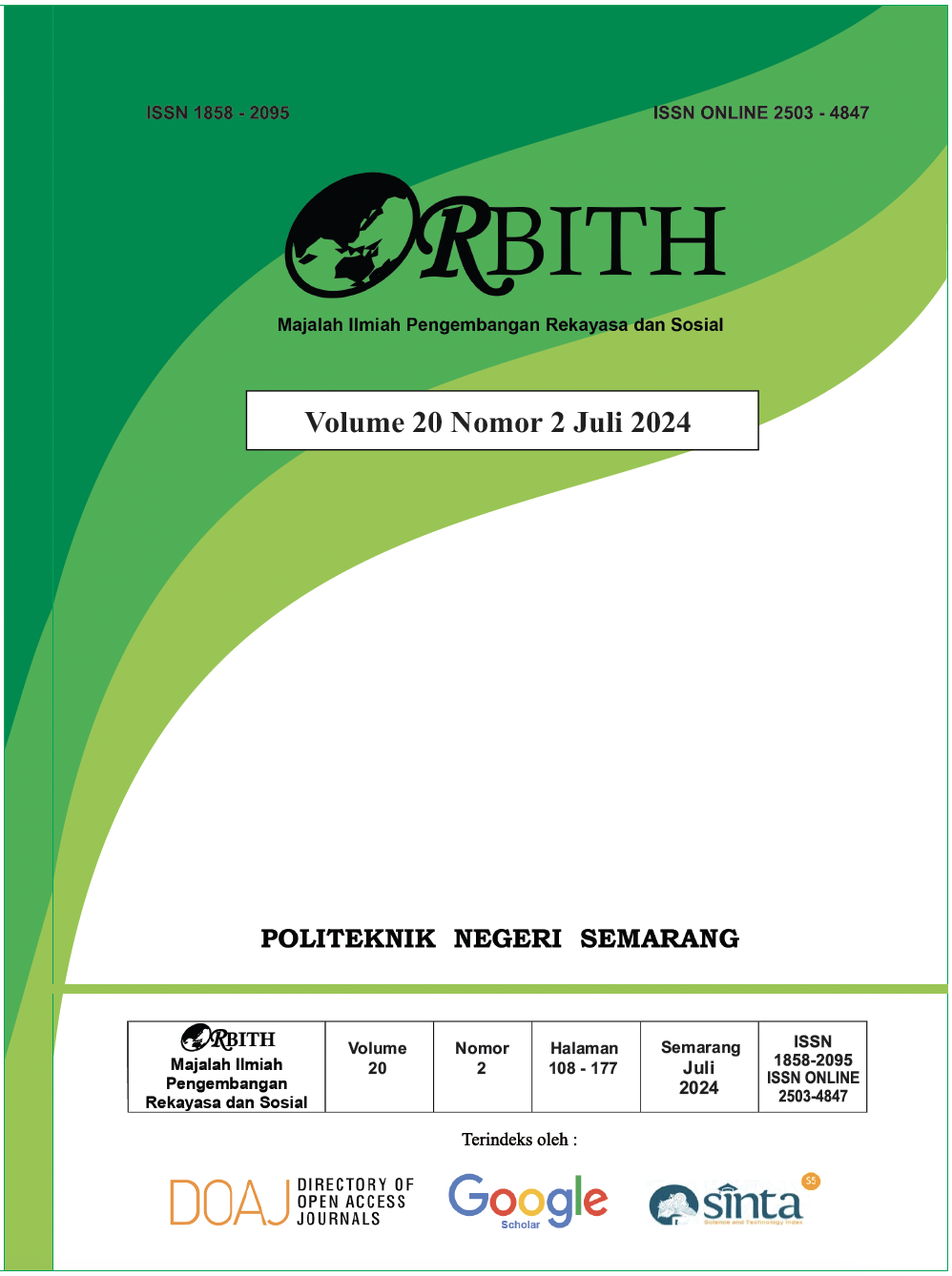IMPLEMENTASI PROVISIONING ROUTER BERBASIS WEB
DOI:
https://doi.org/10.32497/orbith.v20i2.5775Keywords:
Provisioning Jaringan, Phython, Django, ParamikoAbstract
Abstrak
Provisioning merupakan suatu aktivitas dalam network management yang berfokus pada penambahan sumberdaya infrastruktur jaringan baru dengan cara menambahkan router serta melakukan implementasi konfigurasi pada perangkat router ataupun perangkat jaringan. Penyediaan konfigurasi provisioning router pada PT. Indonesia Comnets Plus SBU Regional Jawa Bagian Tengah saat ini masih menggunakan cara manual yaitu dengan melakukan SSH ataupun telnet ke router perangkat jaringan dan melakukan konfigurasi satu per satu. Tujuan dari penelitian ini yaitu membangun suatu infrastruktur untuk perangkat router dengan aplikasi web agar network administrator lebih mudah melakukan konfigurasi dan mengoptimalkan waktu konfigurasi router serta operasi terhadap perangkat-perangkat router dalam satu sistem kontroller yang berbasis web. Pada penelitian ini menggunakan metode Action Research. Metode penelitian Action Research meungkinkan untuk melakukan interpretasi, mendeskripsikan, serta menjelaskan suatu kondisi pada satu waktu dengan melakukan intervensi yang ditujukan untuk partisipasi serta perbaikan. Penelitian ini menggunakan bahasa pemrograman python dengan framework utamanya yaitu Django. Library yang digunakan yaitu Paramiko diterapkan pada suatu infrastruktur perangkat jaringan. Hasil dari penelitian adalah aplikasi kontroller web untuk melakukan provisioning pada perangkat router cisco dan mikrotik.
Kata kunci : Provisioning Jaringan, Phython, Django, Paramiko
Abstract
Provisioning is an activity in network management that focuses on adding new network infrastructure resources by adding routers and implementing configurations on router devices or network devices. Provisioning router provisioning configuration at PT Indonesia Comnets Plus SBU Regional Jawa Bagian Tengah still uses a manual method, namely by doing SSH or telnet to the network device router and configuring it individually. This research aims to build an infrastructure for router devices with web applications so that network administrators can more easily configure and optimize router configuration time and operations on router devices in one web-based controller system. This research is the Action Research method. The Action Research research method makes it possible to interpret, describe, and explain a condition simultaneously by intervening aimed at participation and improvement. This research uses the Python programming language with the main framework, Django. The library used, Paramiko, is applied to a network device infrastructure. The result of the research is a web controller application for Provisioning on Cisco and Mikrotik router devices.
References
Americas Headquarters. 2012. IP Addressing: DHCP Configuration Guide,, San Jose: Cisco Systems, Inc.
Anom, I Gusti Putut. 2016. Sistem Autentifikasi Provisioning Jaringan Wireless Melalui DHCP Server Dengan Menggunakan Layanan Pesan. Jurusan Teknik Informatika ITS, Surabaya.
G.K Sandhu. 2013. Benefit and security issues in wireless technologies: Wifi and WiMax. International Jurnal Innovative Research in Computer and Communication Engineering, vol. 1, no. 4 pp 976-982.
http://www.drizzle.com/aboba/IEEE/rc4_ksa proc.pdf, diakses Januari 2024.
J. Malinen. 2013. Hostapd: IEEE 802.11 AP, IEEE 802.1X/ WPA/ WPA2/EAP/RADIUS Authenticator,” p. http://w1.fi/hostapd/.
J. Vollbrecht. 2022. 802.11b wireless networking and why it needs authentication, dalam Wireless LAN Access Control and Authentication, Ann Arbor, InterlinkNetworks,Inc., pp. 7-29.
Kartini dan Adiansyah W. 2014. Membangun Jaringan Nirkabel (Hotspot Area) dan Manajemen Hotspot dengan Hubungan Antarmedia Hotspot Manager, Sebagai Sarana Komersial Berbasis Wifi. Jurnal Ilmu Komputer (Vol. 10, Nomor 2).
Mashur Gultom. 2021. Seminar Nasional Industri Dan Teknologi (SNIT), Politeknik Negeri Bengkalis : 260”“77.
M.-k. Choi, R. J. Robles, C.-h. Hong dan T.-h. Kim. 2018. Wireless Network Security: Vulnerabilities, Threats and Countermeasures. International Journal of Multimedia and Ubiquitous Engineering, vol. 8, pp. 77-86.
M. S. V. Gawande dan D. P. R. Deshmukh. 2015. Raspberry Pi Technology. International Journal of Advanced Research in Computer Science and Software Engineering, vol. 5, no. 4, pp. 37-40.
Rifki Afandi, M., Hatta, P., Efendi, A., Kunci-Otomatisasi Jaringan, K., Komputer, L., & Jaringan, P. 2020. Otomatisasi Perangkat Jaringan Komputer Menggunakan Ansible Pada Laboratorium Komputer. SMARTICS Journal, 6(2), 48”“53
Rosyid, N. R., & Adhyatmaka Wiryawan, R. 2021. Pengembangan Aplikasi Otomatisasi Administrasi Jaringan Berbasis Website Menggunakan Bahasa Pemrograman Python.
Sylvania Ginting, E., & Hadi, I. 2020. Jurnal Media Informatika Budidarma : Pengujian Konfigurasi Otomatis Penambahan Gateway Pada Virtual Router Menggunakan Aplikasi Otomatisasi Jaringan Berbasis Web. 4, 1126”“1131.
Sofana, Iwan. 2020. Membangun Jaringan Komputer: Mudah Membuat Jaringan Komputer (Wire & Wireless) untuk Pengguna Windows dan Linux. Informatika, Bandung.
S. Powers, 2015. DNSMasq, the Pint-sized Super Daemon. Linux Jurnal, pp.1-2
Tonowidjojo, Rendra. 2020. Konsep dan Implementasi Routing: 100% connected. Jasakom, Jakarta.
Downloads
Published
Issue
Section
License
Authors who publish with this journal agree to the following terms:Authors retain copyright and grant the journal right of first publication with the work simultaneously licensed under a Creative Commons Attribution License that allows others to share the work with an acknowledgement of the work's authorship and initial publication in this journal.
Authors are able to enter into separate, additional contractual arrangements for the non-exclusive distribution of the journal's published version of the work (e.g., post it to an institutional repository or publish it in a book), with an acknowledgement of its initial publication in this journal.
Authors are permitted and encouraged to post their work online (e.g., in institutional repositories or on their website) prior to and during the submission process, as it can lead to productive exchanges, as well as earlier and greater citation of published work (See The Effect of Open Access).






